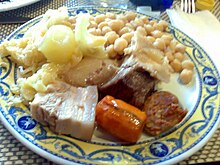Cocido madrileño
This article needs additional citations for verification. (February 2013) |
vegetables and meat | |
| Course | Main course |
|---|---|
| Place of origin | Spain |
| Region or state | Madrid |
| Serving temperature | Hot |
| Main ingredients | Chickpeas |
Cocido madrileño (Spanish: [koˈθiðo maðɾiˈleɲo]; "Madrid stew") is a traditional chickpea-based stew from Madrid, Spain. A substantial dish prepared with meat and vegetables, it is most popular during the winter but is served throughout the year in some restaurants. Initially it was a dish for humble people, but it started to climb in society thanks to its inclusion in restaurant menus. The chickpea was introduced under Carthaginian rule, and was later used in medieval Spain.
It is a dish normally eaten in winter, in the cold months of the year.
History
The origins of the dish are uncertain, but most sources agree that probably it was created during the
].The growth of
From these origins, the recipe allowed few modifications and was soon established as a staple of
Ingredients

The main ingredient of cocido is the
are also added.The meat used is fundamentally
Two bone pieces (ham bone and beef spine bone) are added to enrich the stock.
For some recipes, the final touch is the bola, a
On the table

Tradition rules that the ingredients of cocido must be served separately. Each serving is known as a vuelco (tipping or emptying out), as at each time the
The first vuelco is to separate the
Leftovers
Traditionally, dishes made with the leftovers of the cocido include Spanish croquetas (
See also
- Cocido lebaniego
- Cocido montañés
- Cozido à portuguesa
- Fabada asturiana
- List of stews
- Spanish cuisine
References
- ISBN 9781416579618. Retrieved 21 May 2018.
- ^ "Cocido Madrileño Recipe".

